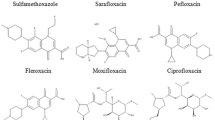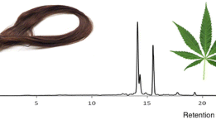Abstract
Recently, many new types of cosmetic illegal additives have been screened in the market. Most of the new additives were new drugs or analogues with very similar structures to other prohibited additives, which were difficult to be identified by liquid chromatography–mass spectrometry (LC–MS) only. Therefore, a new strategy is proposed, which is chromatographic separation combined with nuclear magnetic resonance spectroscopy (NMR) structural identification. The suspected samples were screened by ultra-high-performance liquid chromatography tandem high-resolution mass spectrometry (UPLC-Q-TOF–MS), followed by purification and extraction through silica-gel column chromatography and preparative high-performance liquid chromatography (HPLC). Finally, the extracts were identified unambiguously by NMR as bimatoprost and latanoprost, which were identified to be new cosmetic illegal additives in eyelash serums in China. Meanwhile, bimatoprost and latanoprost were quantified by high-performance liquid chromatography tandem triple quadrupole mass spectrum (HPLC-QQQ-MS/MS). The quantitative method demonstrated good linearity in the range of approximately 0.25–50 ng/mL (R2 > 0.9992), with limit of detection (LOD) and limit of quantification (LOQ) values of 0.01 and 0.03 mg/kg, respectively. The accuracy, precision, and reproducibility were confirmed to be acceptable.
Graphical Abstract





Similar content being viewed by others
References
Woo IS, Kim JH, Kim YK, Kim HI, Shin DW, Kim JH, Beak SY. Development and validation of a simultaneous analytical method for non-steroidal therapeutic compounds in cosmetics using liquid chromatography-tandem mass spectrometry. J Sep Sci. 2021;44(12):2371–81.
Zhan J, Ni ML, Zhao HY, Ge XM, He XY, Yin JY, Yu XJ, Fan YM, Huang ZQ. Multiresidue analysis of 59 nonallowed substances and other contaminants in cosmetics. J Sep Sci. 2014;37(24):3684–90.
Desmedt B, Courselle P, De Beer JO, Rogiers V, Grosber M, Deconinck E, De Paepe K. Overview of skin whitening agents with an insight into the illegal cosmetic market in Europe. J Eur Acad Dermatol Venereol. 2016;30(6):943–50.
Gimeno P, Maggio AF, Bancilhon M, Lassu N, Gornes H, Brenier C, Lempereur L. HPLC-UV Method for the identification and screening of hydroquinone, ethers of hydroquinone and corticosteroids possibly used as skin-whitening agents in illicit cosmetic products. J Chromatogr Sci. 2016;54(3):343–52.
Desmedt B, Rogiers V, Courselle P, De Beer JO, De Paepe K, Deconinck E. Development and validation of a fast chromatographic method for screening and quantification of legal and illegal skin whitening agents. J Pharm Biomed Anal. 2013;83:82–8.
Kim NS, Yoo GJ, Lee JH, Park H-J, Cho S, Shin DW, Kim Y, Baek SY. Determination of 43 prohibited glucocorticoids in cosmetic products using a simultaneous LC-MS/MS method. Anal Methods. 2017;9(13):2104–15.
Jian L, Yuan X, Han J, Zheng R, Peng X, Wang K. Screening for illegal addition of glucocorticoids in adulterated cosmetic products using ultra-performance liquid chromatography/tandem mass spectrometry with precursor ion scanning. Rapid Commun Mass Spectrom. 2021;35(3):e8999.
Yuniati W, Amelia T, Ibrahim S, Damayanti S. Analytical method development for determining formaldehyde in cream cosmetics using hyphenated gas chromatography. ACS Omega. 2021;6(42):28403–9.
Zhou W. The determination of 1,4-dioxane in cosmetic products by gas chromatography with tandem mass spectrometry. J Chromatogr A. 2019;1607:460400.
Arshad H, Mehmood MZ, Shah MH, Abbasi AM. Evaluation of heavy metals in cosmetic products and their health risk assessment. Saudi Pharm J. 2020;28(7):779–90.
Maneli MH, Wiesner L, Tinguely C, Davids LM, Spengane Z, Smith P, van Wyk JC, Jardine A, Khumalo NP. Combinations of potent topical steroids, mercury and hydroquinone are common in internationally manufactured skin-lightening products: a spectroscopic study. Clin Exp Dermatol. 2016;41(2):196–201.
Guo P, Xu X, **an L, Ge Y, Luo Z, Du W, **g W, Zeng A, Chang C, Fu Q. Development of molecularly imprinted column-on line-two dimensional liquid chromatography for rapidly and selectively monitoring estradiol in cosmetics. Talanta. 2016;161:830–7.
Wang M, Guo L, Yu M, Zhao H. The application of a lateral flow immunographic assay to rapidly test for dexamethasone in commercial facial masks. Anal Bioanal Chem. 2019;411(22):5703–10.
Maggio RM, Calvo NL, Vignaduzzo SE, Kaufman TS. Pharmaceutical impurities and degradation products: uses and applications of NMR techniques. J Pharm Biomed Anal. 2014;101:102–22.
Kontogianni VG, Exarchou V, Troganis A, Gerothanassis IP. Rapid and novel discrimination and quantification of oleanolic and ursolic acids in complex plant extracts using two-dimensional nuclear magnetic resonance spectroscopy-comparison with HPLC methods. Anal Chim Acta. 2009;635(2):188–95.
Lin Y, Zeng Q, Lin L, Chen Z. High resolution nuclear magnetic resonance spectroscopy on biological tissue and metabolomics. Curr Med Chem. 2019;26(12):2190–207.
Yang Z. Online hyphenated liquid chromatography-nuclear magnetic resonance spectroscopy-mass spectrometry for drug metabolite and nature product analysis. J Pharm Biomed Anal. 2006;40(3):516–27.
Tolkatchev D. Nuclear magnetic resonance spectroscopy in analysis of granulin three-dimensional structure and cysteine bridging. Methods Mol Biol. 2018;1806:65–80.
Christophoridou S, Dais P, Tseng LH, Spraul M. Separation and identification of phenolic compounds in olive oil by coupling high-performance liquid chromatography with postcolumn solid-phase extraction to nuclear magnetic resonance spectroscopy (LC-SPE-NMR). J Agric Food Chem. 2005;53(12):4667–79.
Bingol K, Bruschweiler R. Multidimensional approaches to NMR-based metabolomics. Anal Chem. 2014;86(1):47–57.
Markley JL, Bruschweiler R, Edison AS, Eghbalnia HR, Powers R, Raftery D, Wishart DS. The future of NMR-based metabolomics. Curr Opin Biotechnol. 2017;43:34–40.
Li S, Tian Y, Jiang P, Lin Y, Liu X, Yang H. Recent advances in the application of metabolomics for food safety control and food quality analyses. Crit Rev Food Sci Nutr. 2021;61(9):1448–69.
Fan TW, Lorkiewicz PK, Sellers K, Moseley HN, Higashi RM, Lane AN. Stable isotope-resolved metabolomics and applications for drug development. Pharmacol Ther. 2012;133(3):366–91.
Fan TW, Lane AN. Applications of NMR spectroscopy to systems biochemistry. Prog Nucl Magn Reson Spectrosc. 2016;92–93:18–53.
Wang Y, Gao X, Yang H. Integrated metabolomics of “big six” Escherichia coli on pea sprouts to organic acid treatments. Food Res Int. 2022;157:111354.
Chen L, Zhao X, Li R, Yang H. Integrated metabolomics and transcriptomics reveal the adaptive responses of Salmonella enterica serovar Typhimurium to thyme and cinnamon oils. Food Res Int. 2022;157:111241.
Katsanos A, Riva I, Bozkurt B, Hollo G, Quaranta L, Oddone F, Irkec M, Dutton GN, Konstas AG. A new look at the safety and tolerability of prostaglandin analogue eyedrops in glaucoma and ocular hypertension. Expert Opin Drug Saf. 2022;21(4):525–39.
Kadri R, Shetty A, Parameshwar D, Kudva AA, Achar A, Shetty J. Effect of prostaglandin analogues on central corneal thickness in patients with glaucoma: a systematic review and meta-analysis with trial sequential analysis. Indian J Ophthalmol. 2022;70(5):1502–12.
Barron-Hernandez YL, Tosti A. Bimatoprost for the treatment of eyelash, eyebrow and scalp alopecia. Expert Opin Investig Drugs. 2017;26(4):515–22.
Steinsapir KD, Steinsapir SMG. Revisiting the safety of prostaglandin analog eyelash growth products. Dermatol Surg. 2021;47(5):658–65.
Zanoni G, D’Alfonso A, Porta A, Feliciani L, Nolan SP, Vidari G. The Meyer-Schuster rearrangement: a new synthetic strategy leading to prostaglandins and their drug analogs, bimatoprost and latanoprost. Tetrahedron. 2010;66(38):7472–8.
Martynow JG, Jóźwik J, Szelejewski W, Achmatowicz O, Kutner A, Wiśniewski K, Winiarski J, Zegrocka-Stendel O, Golebiewski P. A new synthetic approach to high-purity (15R)-latanoprost. Eur J Org Chem. 2007;2007(4):689–703.
Koda N, Tsutsui Y, Niwa H, Ito S, Woodward DF, Watanabe K. Synthesis of prostaglandin F ethanolamide by prostaglandin F synthase and identification of bimatoprost as a potent inhibitor of the enzyme: new enzyme assay method using LC/ESI/MS. Arch Biochem Biophys. 2004;424(2):128–36.
Huang XL, **ng SX, Sun L. Discussion on safety risk of bimatoprost for eyelash growth. Chin J Mod Appl Pharm. 2022;39(9):1253–60.
Alm A, Grierson I, Shields MB. Side effects associated with prostaglandin analog therapy. Surv Ophthalmol. 2008;53(Suppl 1):S93-105.
Wang HY, Sun L, Wang K, Zheng R, Pan C, Xu Y, Lu Y. Determination of five components including bimatoprost in cosmetics. China’s National Medical Products Administration. 2021. https://www.nmpa.gov.cn/xxgk/ggtg/qtggtg/jmhzhptg/20210913172011142.html. Accessed 13 Sep 2021.
Ran X, Yang Z, Chen Y, Yang H. Konjac glucomannan decreases metabolite release of a plant-based fishball analogue during in vitro digestion by affecting amino acid and carbohydrate metabolic pathways. Food Hydrocoll. 2022;129:107623.
Zhao L, Poh CN, Wu J, Zhao X, He Y, Yang H. Effects of electrolysed water combined with ultrasound on inactivation kinetics and metabolite profiles of Escherichia coli biofilms on food contact surface. Innov Food Sci Emerg. 2022;76:102917.
Mao X, **ao W, Wan Y, Li Z, Luo D, Yang H. Dispersive solid-phase extraction using microporous metal-organic framework UiO-66: improving the matrix compounds removal for assaying pesticide residues in organic and conventional vegetables. Food Chem. 2021;345:128807.
Chevolleau S, Bouville A, Debrauwer L. Development and validation of a modified QuEChERS protocol coupled to UHPLC-APCI-MS/MS for the simple and rapid quantification of 16 heterocyclic aromatic amines in cooked beef. Food Chem. 2020;316:126327.
Benincasa C, Perri E, Iannotta N, Scalercio S. LC/ESI–MS/MS method for the identification and quantification of spinosad residues in olive oils. Food Chem. 2011;125(3):1116–20.
Kruve A, Kunnapas A, Herodes K, Leito I. Matrix effects in pesticide multi-residue analysis by liquid chromatography-mass spectrometry. J Chromatogr A. 2008;1187(1–2):58–66.
Acknowledgements
The authors are highly grateful to National Institutes for Food and Drug Control for all-around support and for arranging research facilities.
Author information
Authors and Affiliations
Contributions
Yong Lu: conceptualization; methodology; investigation; writing—original draft. Yu He: methodology; investigation; formal analysis; writing—original draft. **nran Wang: methodology, investigation. Haiyan Wang: conceptualization, validation. Qianqian Qiu: formal analysis and investigation, validation. Bao** Wu: formal analysis and investigation, validation. **anfu Wu: conceptualization; project administration; writing—review and editing.
Corresponding author
Ethics declarations
Conflict of interest
The authors declare no competing interests.
Additional information
Publisher's note
Springer Nature remains neutral with regard to jurisdictional claims in published maps and institutional affiliations.
Supplementary Information
Below is the link to the electronic supplementary material.
Rights and permissions
Springer Nature or its licensor (e.g. a society or other partner) holds exclusive rights to this article under a publishing agreement with the author(s) or other rightsholder(s); author self-archiving of the accepted manuscript version of this article is solely governed by the terms of such publishing agreement and applicable law.
About this article
Cite this article
Lu, Y., He, Y., Wang, X. et al. Screening, characterization, and determination of suspected additives bimatoprost and latanoprost in cosmetics using NMR and LC–MS methods. Anal Bioanal Chem 415, 3549–3558 (2023). https://doi.org/10.1007/s00216-023-04744-1
Received:
Revised:
Accepted:
Published:
Issue Date:
DOI: https://doi.org/10.1007/s00216-023-04744-1




